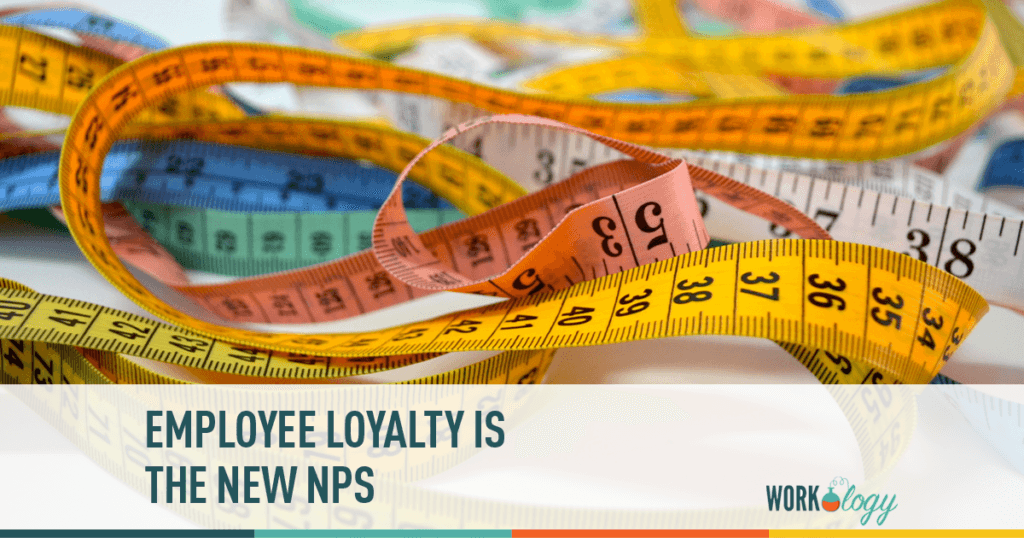Net Promoter Score® or NPS® was developed as a means to measure customer loyalty more quickly and accurately. In a Harvard Business Review article the creator of the system, Frederick F. Reichheld, explained that simply measuring customer retention rates isn’t enough. Attracting a high number of customers is great in the short run, but loyalty is what will help your company grow exponentially in the long run. Loyal customers spread word of your business, lower new customer acquisition costs and chose to use your services, even when confronted with a cheaper option. NPS is based on customer surveys that ask one simple question: “Would you recommend our company to a friend or colleague?”
What is only recently being realized is that HR departments can also use NPS to gauge employee loyalty. Employee Net Promoter score or eNPS, is calculated in the same way, except you’re asking the question, “How likely is it that you would recommend this company as a place to work?”
Loyalty is not simply how long an employee has been with your company, but how committed they are to your company’s success. Based on responses from a sample of HR professionals and employees, Workforce determined that, “loyalty includes being willing to stay through good and bad times, internalizing company goals as personal goals, and giving extra time, energy and commitment to the company when necessary.”
3 Reasons why your company’s eNPS is important
Attracting and retaining employees: One of the top concerns of every HR department is attracting and retaining top talent. Millennials in particular have quite different demands from employers than previous generations. Employees are also the best source for attracting new talent to your company, so keeping your existing team happy pays off in the future. However, Elance/Odesk found that 57% of millennials consider long-term company loyalty to be dead. According to a survey by the American Management Association, declining employee loyalty causes low morale (84%), high turnover (80%), disengagement (80%), growing distrust (76%), and lack of team spirit (73%). To guard your company against high turnover and the inability to attract talent, it’s important to keep track of your eNPS.
Company image: Not only is it about attracting talent, today failing to keep on top of employee loyalty can greatly damage your company’s image. Employees are now free to air their true feelings about their employer on sites like Glassdoor and Indeed. Fortune’s ‘100 Best Companies to Work For’ ranking is based on employee reviews of company culture. In what Josh Bersin of Deloitte terms the ‘ratings economy’, scoring low on these very public channels can greatly impact public confidence in your business. Companies that make it on Fortune’s list experience a 14% average rise in stock prices per year, compared to 6% in the overall market. If you gain your employees’ loyalty, on the other hand, their opinion will be less likely to be swayed even during difficult times that require more overtime without salary increases.
Customer satisfaction: Employee engagement has a major impact on NPS. Your employees are your brand ambassadors and, as such, if they don’t believe in your brand, this will come across to your customers. Creating a strong company culture that helps engage and educate your employees on your company values will greatly impact brand loyalty. Surprisingly, Gallup found only 41% of employees actually know what their company stands for and how their brand differs from competitors.
Recent research has shed light on the strong correlation between employee engagement and customer satisfaction. Through their studies in the airline and grocery industries, researchers Lindsay McGregor and Neel Doshi found this correlation to be so strong that the difference in revenue between salespeople in strong and weak company cultures was 30%.
According to Target Training International, over 60% of customers stop dealing with a company due to perceived indifference on the part of an employee. This figure is quite telling, as indifference is just what could kill employee loyalty at your company.
Calculating your eNPS
To keep on top of your score, it’s important to pulse check your eNPS regularly. Send out quarterly surveys asking your employees to rate on a scale of 1-10, “How likely is it that you would recommend this company as a place to work?” Those employees who answer with a 9-10 out of ten are considered net promoters. Anyone under this number is considered either a passive promoter (7-8) or detractor (0-6). Just like your NPS, your eNPS is calculated by subtracting the number of detractors from the number of net promoters.










One Comment
A good read and I very much agree with the direction. In the last sentence it looks like you have a minor error in the directions for calculating NPS, it should be calculated by subtracting the percentage of detractors from the percentage of promoters. Regards, Mark
Comments are closed.